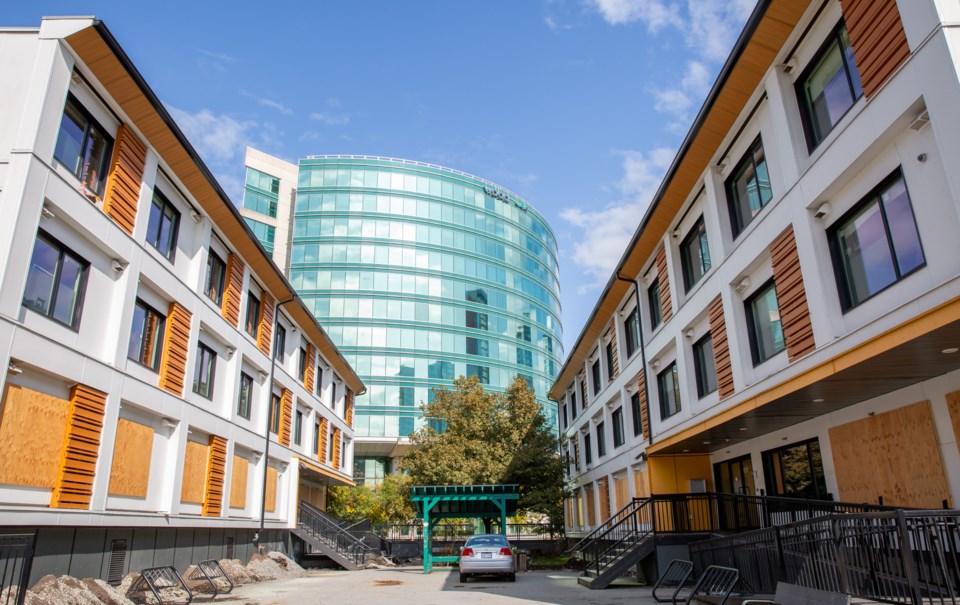A new report from Vancouver city staff reinforces the need for the region’s municipalities to provide supportive housing and overdose prevention sites to deliver a more proportional response to homelessness, drug use and mental health issues.
The push for other municipalities to enhance or simply address social issues via housing and services has been a common refrain from staff for several years.
That refrain will continue Feb. 25 when staff presents a detailed analysis to support a regional approach to the crises.
Using provincial government-mandated housing needs reports for municipalities and other data, city staff calculated that roughly 2,200-2,900 supportive housing units are required across the region over the next five years.
Population data modelling for overdose prevention sites shows another 29 sites should be operating across the region, including in those municipalities that don’t offer the service. That includes Burnaby, Richmond, the North Shore and Delta.
8,150 supportive housing units
As of 2023, there were 8,150 supportive housing units across the region, with 77 per cent in Vancouver, which has 25 per cent of the region’s total population.
Based on a 2024 analysis of overdose prevention sites across the metro region, Vancouver has 14, which is 47 per cent of the total of 30 sites across the region.
A similar imbalance exists with shelters: there are approximately 2,088 shelter spaces across the region, with 67 per cent in Vancouver.
Staff’s analysis comes after Mayor Ken Sim announced Jan. 23 that he wants a pause on the construction of any new supportive housing in Vancouver. That does not include projects already in the development pipeline or housing being built to replace existing housing.
At the same time, mayors such as Burnaby’s Mike Hurley has told BIV that Sim’s proposal — which will go before council Feb. 26 — doesn’t trigger his city to begin building more supportive housing.
Hurley estimated Burnaby has 200 supportive housing units.
The city staff report suggests Burnaby should build another 278 more over the next five years. Hurley said the municipality is not opposed to building more supportive housing, but emphasized money to build and operate the housing must come from the provincial government.
Housing Supply Act
In 2022, the B.C. government introduced the Housing Supply Act, which enables the province to set housing supply targets for municipalities based on need and projected growth.
In 2023, the government introduced mandatory “housing target orders” for a first cohort of 10 municipalities, including Vancouver. There are now 12 Metro Vancouver municipalities with housing target orders.
However, the government didn’t include mandatory targets for supportive housing.
That’s why Vancouver city staff conducted the analysis.
Staff suggested that once all Metro Vancouver municipalities receive their “housing target orders” from the provincial government, roughly 75 per cent of new supportive housing will be allocated to municipalities outside of Vancouver.
That calculation is based on the housing needs assessment for each municipality.
“The rate of growth in supportive housing resources will be much faster outside the City of Vancouver, with a targeted 8% growth rate in the city compared to over 50% growth rate in the City of Surrey, and potentially significantly higher growth rates in municipalities that have not yet received [housing target orders],” the report said.
Surrey, Burnaby, Richmond
A chart included in the report shows Vancouver would be responsible for an additional 777 supportive housing units while other municipalities to see their portion increase would include Surrey (603), Burnaby (278), Richmond (235), Delta (127), Coquitlam (166), New Westminster (84), North Vancouver (167) and Langley (179).
Sim said in an interview Thursday his call for a pause on “net new supportive housing” is not connected in any way to complaints or behaviour of tenants, many of whom are living with a mental illness, substance use disorder, or both.
“There are supportive housing units that work incredibly well,” he said, pointing to Naomi Place, a temporary modular housing building on Copley Street.
“So what you need to do is decouple the two comments. First, the general comment is, we have crumbling stock, and we take on 77 per cent of the region’s supportive housing, and we only represent 25 per cent of the population. The second part which you need to decouple is there are problematic places that need attention, but that's independent of this.”
The Ministry of Municipal Affairs said in an email Monday that overall housing targets for each municipality are mandatory.
"Within the targets are recommendations from the Province on how best to meet the estimated housing need for the community. These recommendations include supportive housing units, below market, etc.," the ministry said. "While municipalities are encouraged to follow these recommendations, they are not mandatory. It is up to the municipality to decide how to achieve its targets."
Note: This story has been updated since first posted to include an explanation from the Ministry of Municipal Affairs on housing targets.
X/@Howellings




